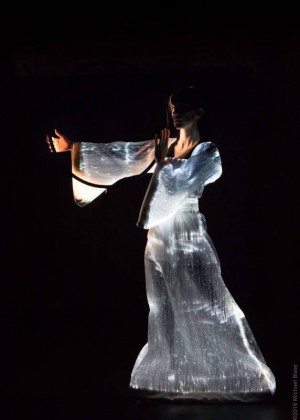

Vangeline Theater opened its run of Butoh Beethoven at the Producer’s Club Royal this week. A solo work praised for its striking imagery and emotional journey, it did not disappoint.
Choreographed and performed by Vangeline, a French-born dancer and performer, Butoh Beethoven’s first act was set to the well-worn tune of Ludwig van Beethoven’s Symphony No. 5 and Paul Verlaine’s 1866 poem "Autumn Song." The evening begins in complete darkness, save for a glowing semicircle of stones onstage. Tension mounts as strobe effect lighting begins to reveal Vangeline’s figure at its center, the light creating angles of darkness across her white-painted face. A glowing baton appears, and circles, like the minute hand of a clock moving backwards in time. Amid a soundscape of bells, planes flying low, and air-raid sirens, Vangeline herself turns backwards in time and space to face a line of pig’s head masks strung across the back of the stage. She sheds the black robe cloaking her, and bows to recorded applause, as a conductor does to his audience, before turning towards us—playing the roles of both audience and orchestra—in the silence of all-white garb.
Butoh Beethoven was conceived by Vangeline as a tribute to both the German composer, and the late Tatsumi Hijikata, one of the founders of Butoh as a Japanese art form. In this first act, Vangeline seamlessly embodies the two ghosts simultaneously. She begins to conduct, in all its delicate intricacy, an imaginary orchestra as it fills the small theater with the increasingly victorious sounds of Beethoven’s fifth. In the midst of a truly captivating conducting performance (she studied conducting for months during the creation of this piece), Vangeline’s tribute to Hijikata shines through. Her body is minutely twisted and angled in a demonstration of precise choreographic grace, which is juxtaposed with the grotesque contortion of her facial features in true Butoh tradition.
The power of Butoh lies in its willingness to confront ugliness head-on. And as the evening continues, we are transported through time, to an oft-overlooked dark period in Japan’s history, and Hijikata’s role in repairing a country and culture after the ugliest of world-altering defeats. World War II is conjured repeatedly through Vangeline’s use of air-raid sirens and red strobe lighting. And we hear, in the second half of the first act, the words of French poet Paul Verlaine, whose famous poem, "Chanson d’Automne," played a crucial role in communications with the French Resistance during the war.
The second act of the evening, Eclipse, opens in complete darkness again. Vangeline’s robe is outfitted with fiber optic lights, which create an ethereal effect that is striking in contrast to the concrete imagery presented in the first act. Shrouded in darkness, save for the dress and a hoop, also outfitted with small lights, on the floor, she melts across the stage. Her movement is so controlled and fluid that it’s hard to tell, in the moment, if she is actually moving.
Set to a soundscape ranging from the Himalayas to New York City, Vangeline dances a calmness over us. Where her first act was heavy with the memory of battles fought and European turmoil, the second act uses continual, placid movement to convey rebirth, and a slow healing of the world. The culminating action of this second act is hanging the lighted hoop; in effect, creating the image of a solar eclipse against the back wall of the stage.
In a demonstration of strength both muscular and mental, and against the backdrop of a crushed Japan struggling to recreate itself, Vangeline tells the story of Butoh through Butoh, and tells it beautifully.